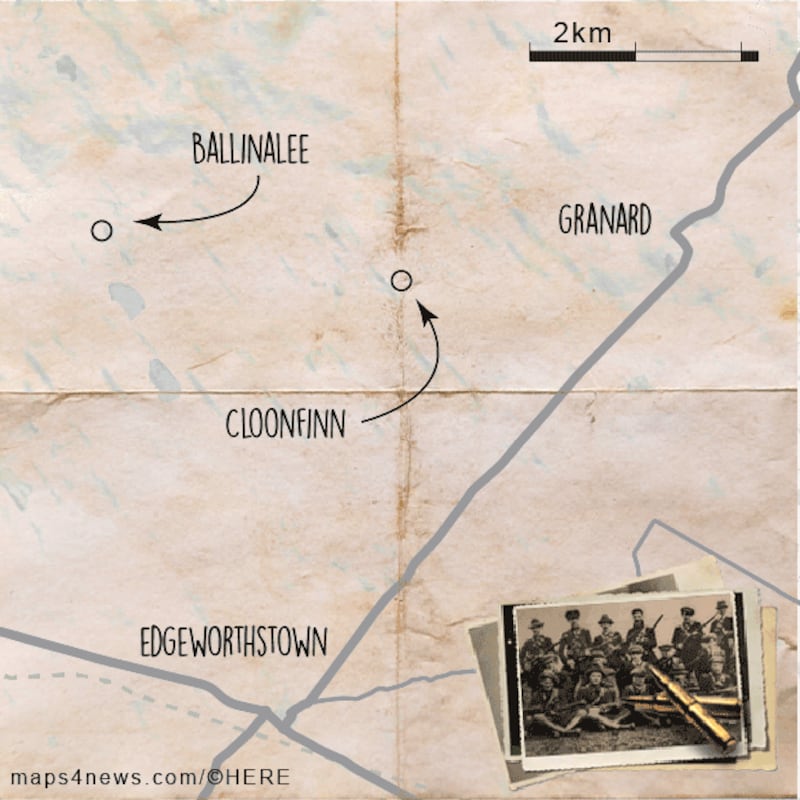County: Longford
Incident: Clonfin ambush
Date: February 2nd 1921
Fatalities: 4
Gen Seán Mac Eoin, known as the ‘Blacksmith of Ballinalee’, was widely regarded as one of the most successful IRA commanders during the War of Independence.
His defence of Ballinalee from the Black and Tans in November 1920 and the Clonfin ambush of February 1921, at which four auxiliaries were killed and eight wounded, were regarded as models of guerrilla warfare.
Mac Eoin went on to become a general in the Free State army, a Government minister and presidential candidate for Fine Gael on two occasions.
Yet the testimony he provided to the referees and advisory committee overseeing the issuing of military pensions was “irresponsibly credulous as to strain charity,” according to Tadgh MacFirbisigh, one of the referees adjudicating on claims.
Mac Eoin was the chair of the Longford Brigade Committee, which was set up to provide a list of engagements against Crown forces in the county.
The committee includes a claim that 15 Black and Tan deaths occurred during the Battle of Ballinalee where, in fact, none occurred.

Six deaths at Clonfin were claimed for, not the four that occurred. Three deaths were reported for an ambush in Turlough which resulted in a single fatality – an RIC man. Three are recorded also as having been killed in ambushes at Tarmonbarry and Clondra, though there are no records of fatalities for either incident.
Queen's University Belfast historian Dr Marie Coleman, who carried out a detailed analysis of the brigade activity reports for Longford, says her research and that of Prof Eunan O'Halpin lists 15 dead for the county during the War of Independence.
She calculates that the BAR committee reports includes at least 27 more – almost tripling the number of dead in Longford and concludes the committee’s reports for the county were “careless and negligent to say the least”.
In order to qualify for a military pension, an applicant had to have participated in at least two major engagements. An action where a member of the Crown forces was killed qualified as a major engagement.
The assessors shared the same incredulity about the evidence presented to them by Mac Eoin’s committee.
They checked contemporary newspaper reports and could find no evidence for several of the ambushes claimed for in the files.
In his report published in 1945, MacFirbisigh, the one who said Mac Eoin’s testimony “strained credulity”, believed there was “grave grounds for suspicion but not positive proof to date, that there was a good many other cases of blatant fraud in this county”.
He noted Mac Eoin had sought to enhance the claims of his former comrades as they were also his Dáil constituents and therefore voters.
Mac Eoin unsuccessfully claimed for a Mediterranean cruise to help heal his war wounds, his personal pension file reveals.
Mac Eoin was captured in March 1921 and sentenced to death, but his sentence was commuted once the Truce came into force. He successfully claimed that the chronic bronchitis he suffered from in his later years was a result of a gunshot wound to the chest incurred when he was captured.
In July 1954, the Pensions Board stated that he was entitled to six weeks' convalescence in a warm climate, either the south of France or the east coast of Spain. In correspondence, Mac Eoin said treatment for his condition was described as "sun and more sun", according to his doctor Leonard Abrahamson, the grandfather of film director Lenny Abrahamson.
In 1961, Mac Eoin submitted an invoice for £181.7.0 (€5,000 today) for a Mediterranean cruise following a recurrence of a chest complaint.
The board turned it down on the basis that a cruise “can hardly be regarded as treatment in a hospital, nursing home or other like institution”.









